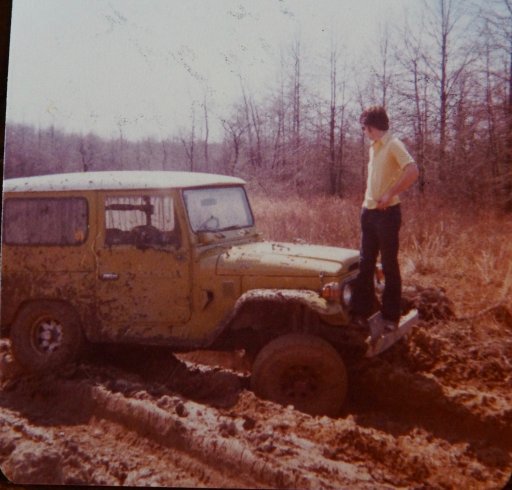OB Approved Basic Vehicle Recovery
- Thread starter Dunco
- Start date
-
Guest, UPDATE We went through the site migration runbook and completed all steps. We will need to complete the migration next week, but will leave the forums up for the weekend. A few days after maintenance, a major upgrade revision to the forum site will occur.
great tipVery nice write up! The one thing I would add, and I'm not sure if others do this or not, is to (if able to safely) open the hood up on the winching vehicle. That way if something "happens" to come loose, your thimble or clevis (never a hook!) doesn't come flying back thru your window!
Thank you for this! Answered several of my questions and confirmed some things i had always held to.

Enthusiast III

Off-Road Ranger I
- 2,865
- First Name
- Donald
- Last Name
- Diehl
- Member #
-
0745
- Ham/GMRS Callsign
- WRPN 506
Nice write up. When I was coming up there just wasn't any information at all other than a few OSHA handbooks for rigging, so I relied on my wit, and fell back on my farming backround to get out of trouble. It is amazing what a simple shovel, a stock bottle jack and a bit of labor can get you out of. The school of hard knocks taught me a lot along the way. Today I carry a bag of stuff along with a winch, high-lift, bottle jack and 2 shovels. A lot of the extraction equipment we have today is a really nice convenience. Here I am circa 1977, learning about open diffs, bottle jacks and shovels. 


Contributor I
Great write up.
As mentioned elsewhere, many of us know the gist of it, getting a more technical explanation/write up is most welcomed an useful.
As mentioned elsewhere, many of us know the gist of it, getting a more technical explanation/write up is most welcomed an useful.
Boostpowered
Rank VI

Member III
What do you do when high centered on a crest of a 45° hill and your wheeling alone? Would you jack up the rear and stack rocks under the rear tires til you can get over? Would you back down and not continue? What if backing down isnt an option because the is a mud pit at the bottom on a corner on the edge of a cliff and the more you try to reverse the more your rig starts to slide over the cliff. There is only a tree to the left of the truck to winch from so only thing you can do is secure your rig to the tree so it doesn't slide off the cliff. Ive been in this situation recently and half of the decisions i made were terrible i did not stop and think, stress took over because of the danger level and my thinking was fogged, luckily i had enough instinct to save my truck and luckily it was a well used trail another wheeler showed up and helped tow me back to safety. In hindsight i should have never backed down when i got high centered i should have stacked rocks under my rear tires and continued over the hill. Now im trying to finding places that i can safely get high centered and practice getting out alone so this never happens again.

Pathfinder II
I really love the roots LC FJ 40 series. I've learned to drive on my father's FJ 40. It's an awesome rig!!!Nice write up. When I was coming up there just wasn't any information at all other than a few OSHA handbooks for rigging, so I relied on my wit, and fell back on my farming backround to get out of trouble. It is amazing what a simple shovel, a stock bottle jack and a bit of labor can get you out of. The school of hard knocks taught me a lot along the way. Today I carry a bag of stuff along with a winch, high-lift, bottle jack and 2 shovels. A lot of the extraction equipment we have today is a really nice convenience. Here I am circa 1977, learning about open diffs, bottle jacks and shovels. View attachment 70252

Pathfinder I
Wow, using the winch isn't just hook up and pull. Excellent write up. You have given me lots to look into.

Member III
- 2,827
- First Name
- Kevin
- Last Name
- Trvlr
- Member #
-
20466
- Ham/GMRS Callsign
- KK7NAZ
- Service Branch
- MM1 US Navy
That's a nice, concise write up and it covers a lot of things and situations.
All I can add is if you're new to this or a new winch owner. Go out with a buddy or 2 on a nice, warm, sunny day and find a place to become "stuck". By that I mean a nice, dry place not really stuck. Pull your cable, use your tree strap and slowly winch yourself 30-40 feet.
The time to learn and practice is on a nice day with a couple of friends and NO stress. Once you have winched yourself a couple of times, maybe on flat ground and a 10-20* hill you'll have an understanding on how your winch works and what to do to get it hooked up and ready to use. That alone will take a huge amount of stress out of recovering yourself or someone else.
The time NOT to learn is on a cold, wet, night buried in the mud on a side hill.
All I can add is if you're new to this or a new winch owner. Go out with a buddy or 2 on a nice, warm, sunny day and find a place to become "stuck". By that I mean a nice, dry place not really stuck. Pull your cable, use your tree strap and slowly winch yourself 30-40 feet.
The time to learn and practice is on a nice day with a couple of friends and NO stress. Once you have winched yourself a couple of times, maybe on flat ground and a 10-20* hill you'll have an understanding on how your winch works and what to do to get it hooked up and ready to use. That alone will take a huge amount of stress out of recovering yourself or someone else.
The time NOT to learn is on a cold, wet, night buried in the mud on a side hill.

Pathfinder III
- 1,876
- First Name
- Kyle
- Last Name
- Betts
- Member #
-
13310
- Ham/GMRS Callsign
- KF0AWV
That's really useful information. I'm considering putting it on some reference cards to keep in my recovery kit.
On the note of hand/arm signals, is there an approved OB hand & arm signaling guide for vehicle recovery (like the one posted here)? If not, maybe this is something we could consider standardizing. If nothing else, it would surely make communication easier when traveling with other OB members. I realize that we're 46,934 members strong and it would be a big project to solicit ideas or get buy in from all. But I'm sure it would be worth it.
On the note of hand/arm signals, is there an approved OB hand & arm signaling guide for vehicle recovery (like the one posted here)? If not, maybe this is something we could consider standardizing. If nothing else, it would surely make communication easier when traveling with other OB members. I realize that we're 46,934 members strong and it would be a big project to solicit ideas or get buy in from all. But I'm sure it would be worth it.

Off-Road Ranger I
Thanks all have not been around for a while but appreciate the feedback, things have come a lonnnnng way since posting this have a version 2, 3,4 and 5 i will endeavor to get up if i can remember how lol
madcratebuilder
Rank V

Pathfinder I
New winch users should Google "Winch Duty Cycle". Most winch makers do not have a listed duty cycle, a few high end models do and it's around 5% at rated load.

Advocate III
- 5,584
- First Name
- Michael
- Last Name
- Rose
- Member #
-
20990
- Ham/GMRS Callsign
- W7FSB
- Service Branch
- US ARMY Retired
Get a hydro winch...100% duty cycle running off a pto.New winch users should Google "Winch Duty Cycle". Most winch makers do not have a listed duty cycle, a few high end models do and it's around 5% at rated load.



